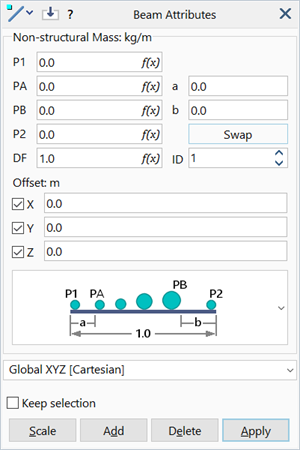Beam Attributes: Non-structural Mass

Description
Assigns a distribution of non-structural mass to selected beam elements.
The distribution can be constant, linear, triangular or trapezoidal. It can act over the whole or partial length of the beam. A dynamic scaling factor and optional offset can also be specified.
Non-structural mass attributes are load case dependent.
Dialog
P1 / P2 / PA / PB
Scalar value of distributed mass at different points along the beam. The distributed mass is linearly interpolated between these points.
-
P1
Distributed mass value at end 1.
-
P2
Distributed mass value at end 2.
-
PA
Distributed mass value at position a.
-
PB
Distributed mass value at position b.
a / b
Distance of points PA and PB from each end, specified as a fraction of the element's length.
Non-dimensional values in the range 0 to 1.
-
a
Relative distance from end 1 of the beam. Determines the position of PA. At end 1, a=0.0.
-
b
Relative distance from end 2 of the beam. Determines the position of PB. At end 2, b=0.0.
DF
A dynamic factor that scales the non-structural mass for dynamic analysis and, optionally, for seismic load cases.
Swap
Swaps the values of a and b, P1 and P2, PA and PB.
ID
Assigns an ID to the attribute.
By using different IDs, multiple masses can be applied on the same element for the same load case.
IDs are positive integers between 1 and 192.
Distribution Type
The distribution type includes constant, linear, triangular and trapezoidal over the whole or partial length of the element.
The appropriate text boxes will be active depending on the distribution selected.
Offset X / Y / Z
Three components that define the magnitude and direction of the offset of the mass from the beam.
When offsets are used, linear acceleration acting on a non-structural mass may produce moments in addition to forces.
Coordinate System
The coordinate system (UCS) in which the offset components are defined.
The UCS is used only to define the global Cartesian components of the offset. Subsequent changes to the UCS do not affect the offset location.
Common Controls
Units
Components: Mass/Length (e.g., kg/m, lb/in).
Relative Distances: Dimensionless.
Common Uses
Non-structural mass attributes are commonly used to include live and non-structural dead loads on the structure. Furniture in a building for example, when modelled as non-structural mass, generates not only self-weight due to gravity in static analysis but also contribute mass and inertia to the system in dynamic analysis. The dynamic effect of the mass can be scaled by the dynamic factor parameter.
See Also